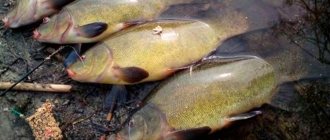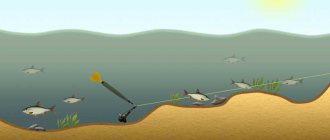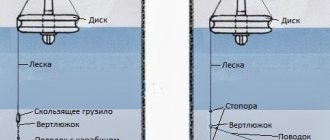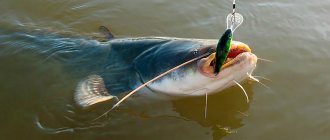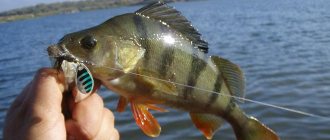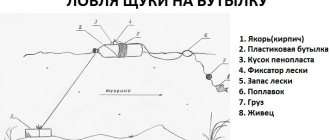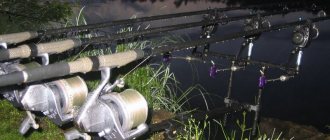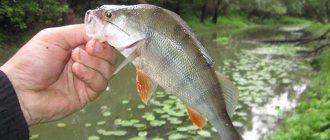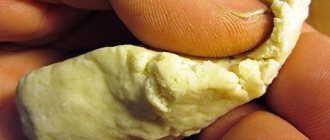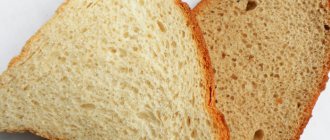The search for trophy specimens often leads the fisherman to the need to try out new and promising baits. Unusual attachments such as sausage, dried blood, and lard are often used. Fishing with lard shows good results; the best effect is in the cold season, when the prey swims in search of a nutritious product. Fishing with lard and garlic is convenient, since you can take provisions and bait with you at the same time, and the garlic smell spreads well throughout the reservoir, attracting its inhabitants.
What kind of fish can you catch with lard?
Content
In domestic reservoirs, carp, which also love the aroma of garlic, are good candidates for high-calorie bait. Catching bream with lard often proves effective, because it always has a good appetite. In a fit of gluttony, he will enjoy lard with greater pleasure than cereals. In almost all reservoirs you can catch bream with such an unusual bait. Catching roach with lard is also effective in early spring and autumn.
Pieces of lard on a hook attract:
- crucian carp;
- bream, white bream;
- soma;
- ide;
- carp;
- silver bream;
- tench;
- saberfish;
- large specimens of rudd and roach.
Catching roach occurs exclusively in large sizes, since small individuals are not able to eat lard. The bait is useless against fish with weak mouthparts.
Carp fish work best on high-calorie bait
Which lard is better
For fishing to bring good results, you first need to choose the “right” product. It must have a certain consistency and meet certain requirements.
It is best to choose lard obtained from pigs fed grain, corn and mixed feed. This semi-finished product has a rich taste and wonderful aroma. The price may be a little higher, but it's worth it.
Another rather “catchable” product is lard with streaks. It is excellent for catching crucian carp, bream and silver bream. Bacon must be fresh, have a pleasant taste and smell, as they say, literally “melt in your mouth.”
The next option is smoked lard. It is used for catching roach and sabrefish in different water horizons. A special feature of the product is that it floats up after casting.
On days with good fish activity, bait with meat veins works well. Before casting, we trim off the meat pieces, cut them into small cubes and catch large bream, ides and even catfish.
There is sometimes a dispute among fishermen about which lard is better: salted or unleavened. Each option has many followers, but remember that salt is a natural preservative that helps preserve organic bait. Before fishing, you just need to cut off the salty skin, attach it to a hook and throw it into the pond. Water will wash away the remaining salt and improve the taste of the product.
Read: Lamprey larvae. Tips for preparing and storing bait
Choosing lard for fishing
A fisherman should know that fishing success directly depends on the quality and correct choice of bait.
Various fishermen claim that you can catch bream on:
- fresh product without veins;
- salted, soft lard;
- fresh product that has small veins;
- smoked lard with skin;
- lard with garlic.
No one method can be called the best bait; they all have their place in fishing, and the specific choice depends on the preferences of the fish in the reservoir.
Regardless of the method of preparing the nozzle, it is important to adhere to the basic rules:
- It is better to use lard with a high density. If it acquires the consistency of lard or flows under the influence of temperature, the risk of the bait flying off during casting increases. It is important to use only a product that holds well on the hook;
- Fishing with lard with or without garlic will be effective if the bait is cut correctly. If, during the preparation of bait or fishing bait, lard cut into cubes less than 3 mm was used, a lot of small things will float onto the bait. Cubes that are too large will not allow interested fish to swallow the bait;
- the freshness of the product is the key to good fishing; carp will not covet a bait with a rancid smell.
Read more
Lures for catching carp
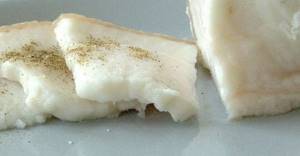
Fishing success depends on the quality and correct choice of bait.
How to properly attach lard to a hook
You should not hook lard that has just been taken out of the freezer. At the fishing site, it is better to place the bait in a container and fill it with water to soak it. The lard should not look like regular cubes; it is necessary that under the influence of water the pieces begin to resemble a shapeless mass. This is necessary in order to appear as natural food to the fish.
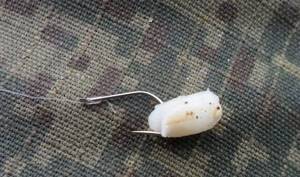
There are several ways to place bait on a hook. This can be a nozzle with a closed or open tip, or a hair attachment. It is believed that to catch a big fish, there is no need to hide the sting; this will not scare away a large fish, but it will be easier for it to escape.
Preparing lard for fishing
Special preliminary preparation of lard before fishing is not required, but there are several points that simplify fishing:
- It is better to store lard in the freezer until departure. Slightly thawed lard is easier to prepare;
- if you plan to use salted lard, you should first salt it and let it brew for a day or two;
- to avoid mistakes, it is better to have several prepared varieties of lard with you at the same time;
- The addition of maggots and bloodworms will help increase the efficiency of all fishing methods - this is a favorite food that is designed to attract attention to the main “dish”;
- sometimes the fish refuses to be caught on the cubes. If this has been observed before, we cut off the edges from the pieces of lard in advance so that they turn out round;
- Only part of the bait is pre-cut, since larger or smaller sizes may be required as fishing progresses; we prepare them right on the spot;
- To increase the activity of biting, it is advisable to use flavorings. Products with spicy aromas are used as natural flavors: pepper, garlic, cloves, cinnamon. An easier and more expensive option is to use store-bought sprays.
Fishing baits. Lard for large carp (smoked lard).
Both experienced fishermen and relevant thematic publications have been talking a lot about the addiction of representatives of the carp family to “meat” food for a long time.
One of the suitable baits for carp fishing is ordinary lard, commonly called smoked lard.
Naturally, from the point of view of a novice fisherman, such a bait looks very unusual and has a more traditional use as a snack for the fisherman himself, rather than bait for carp (carp).
However, its effectiveness has been noted in “hunting” specifically for large representatives of the underwater kingdom in autumn and even winter. This love of carp for lard can be explained, firstly, by its amazing smell, which lures fish, and secondly, by the high calorie content of this bait.
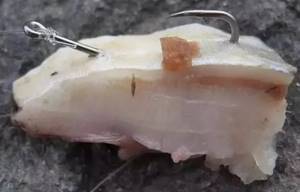
In addition, not only the “crushing” of the bait, but also the manifestation of interest in it by small fish is practically excluded, which makes fishing much quieter due to the absence of meaningless hooks and checks of gear. For example, even in reservoirs densely populated with small fish, it was possible, while maintaining my nerves, to wait for a confident bite of 3 and even 5 kilogram “monsters” using smoked lard.
Lard is more suitable for bottom tackle than for a float rod, however, experienced people will be able to tell about its successful use as a surface floating bait when fishing for carp (carp) from the surface.
The only requirement for the quality of lard is that the lard must be fresh and not have meat layers. That is, fishing is carried out precisely on the fatty layer of smoked lard.
Typically, when bottom fishing, the bacon is cut into cubes of about 10 mm in size, while when fishing from the surface of the water, cubes of 6-8 mm in size are sufficient. When mounting the tackle, in both cases it is preferable to use hooks from No. 4 to No. 6.
Accordingly, if fishing takes place from the bottom, the load is selected taking into account the buoyancy of the bacon, so as to prevent it from floating. Fishing from the surface can be successfully done without additional weights. This is explained by the positive buoyancy of smoked lard.
Place the bacon on the hook in the same way as boiled potatoes. It’s only after the final insertion of the hook point into it that the lard is slightly compressed with the fingers from the sides.
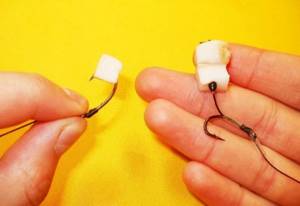
This attachment is ideal because it can be easily obtained at markets or from friends who smoke meat products on their own. Lard stores well in the refrigerator and is easily “stocked up” for future use.
It is undesirable to use as an attachment lard that is smoked with “liquid smoke”, as well as sold in vacuum packaging in our supermarkets. The effectiveness of such a “chemicalized” attachment is not guaranteed by anyone.
Sometimes pre-treatment of lard with bite activators and “garlic”, “plum”, etc. flavors has a good effect.
Due to the availability of such bait, it would be a good idea for an amateur fisherman to add it to his arsenal of baits during his next trip to carp fishing.
How to make bait from lard
The bait will be really catchy if you take into account the following important tips:
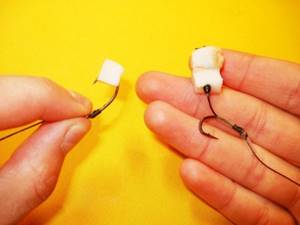
Important points to consider when using lard as bait
- Pre-cut lard for bait and bait into cubes at home. It is best to use 5mm cubes. This condition is important, since it is much easier to cut frozen lard than an already melted product. For large carp, it is better to cut 1 cm cubes;
- For carp and bream, it is advisable to use a hair rig or attach 2-4 small pieces of lard, imitating the appearance of maggots;
- If you plan to catch cautious, large carp, we recommend hiding fishing hooks inside the lard. The main thing is to hide the edge. Carp tend to try the bait for a long time before taking it; when they feel a sharp metal object, they will swim away;
- When using double and treble hooks, a monofilament fishing line is used, and small balls of lard are strung on each point.
The correct way to fish
Every minute a perch for lard, all the facts in this video
Catching perch with lard in the fall and winter has a favorable outcome when using lard on the following baits:
- Donka;
- Feeders;
- Fishing rods.
Fishing with a rod is especially good when you are fishing in a strong current. An important piece of advice is to try to change the cubes as often as possible. Make no more than 10-15 casts with one bait.
You need to remember the fact that perch is a rather finicky marine inhabitant. And any weather changes - thunderstorm, heavy rain, wind and snow. They can play a cruel joke on you, since the perch may even go into the depths and not even stick out. But paradoxically, in cloudy times the perch bites quite well. In these cases, try to come fishing as early as possible. In times of bad weather, lard will be your best helper. Only perch bites best on it at this time.
Pay attention to the pressure. It is a fact that in low atmospheric pressure, it is easiest to catch a large specimen. When everything is calm and there are no significant changes, the perch can calmly peck at the worms.
Features of fishing with lard
Fishing with lard and garlic is actively used in combination with three main types of gear:
- float fishing;
- bottom fishing;
- masking the hooks on the donkey.
Each method is used for a specific type of fish.
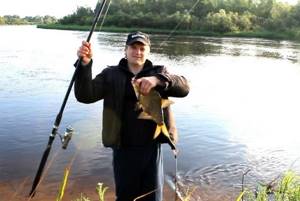
It is best to catch crucian carp using float tackle with lard
Float fishing
Nothing extraordinary is required from a fisherman with a float rod, although there are certain specifics of lard fishing. Such tackle is suitable for catching small carp: crucian carp, roach and medium-sized carp, bream. It is best to catch crucian carp using float tackle with lard. It is preferable to use sports floats for fishing that have 2 fastenings. The design with two loops better transmits bites and allows you to feel the vibrations of the bait during windy weather.
Read more
What is a nailball jig?
It is better to use a main thread with a diameter of 0.2 mm and a driving material of 0.14 mm. Be sure to install strong and sharpened hooks that can pierce the lip when hooking a fish. Some fishermen leave the tip open to simplify hooking.
Lard is not only a successful bait, but is also included in the bait. To prepare the bait mixture, mix lard with bloodworms and maggots. To make the bait heavier, add clay or soil to the mixture, and sand to loosen the bait.
Fishing with donks and feeder
Mainly used for catching large or trophy specimens. If the angler's goal is a large fish, it is not advisable to use bait cubes up to 1 cm. A peppered or garlic piece of lard is extremely attractive to adult specimens of ide, catfish, carp, and bream.
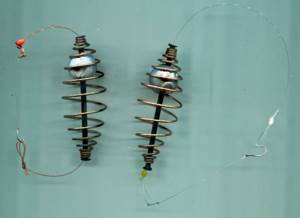
Donkey and feeder fishing are used to catch large specimens
Bottom gear is equipped in one of two ways:
- lard bait on a leash, without using a feeder;
- use of a feeder, 2-3 leashes are attached to it.
The base can use open or half-closed feeders in combination with several leashes. During the rigging process, it is important to be careful that the fish does not bump into the point while testing the bait, but the hook should easily penetrate the bait when hooking. Lard is placed inside the feeder in combination with boiled rice.
Large hooks should be placed on the catfish, on which larger pieces of bait are strung. Catfish respond better to the streaky product due to its attractive aroma. Long-term heating of lard in the sun or smoking will help to enhance the smell even more. Catfish are the orderly of a reservoir, carrion is a favorite delicacy of fish, so spoiled lard is suitable for catching it, but this rule does not apply to carp.
Using lard to disguise hooks near the feeder
Some famous fishermen use lard exclusively for camouflage purposes, preventing detection of hooks. This trick increases the likelihood of catching particularly wary fish that are scared away by the foam. The main disadvantage of the rig is the risk of being hooked by crayfish, which are accustomed to feasting on dead animals. In some reservoirs, this tackle is used exclusively for catching crayfish.
Regional and seasonal features of fishing bream for lard
This fish is found in most lakes, rivers and ponds located in the middle zone. However, each region has its own characteristics of fishing and lard fishing. Those who like to sit with a fishing rod on the Moscow canal are convinced that bream bite on such bait exclusively in the summer, without attaching importance to its taste. It is important that it is fresh.
To learn more:
Twister bait: the subtleties of fishing for perch and pike

Those who throw gear into the water from the banks of the Oka go with lard to catch this fish. On the river, effective catches using this bait do not depend on the time of year, temperature, or time of day - the bite will always be there. And Ural fishermen are convinced that bream in the region bite on lard during the last two months of autumn. The Volga, Don and other bodies of water have their own characteristics, which depend on the place of fishing and the time of year. It has been proven by practice that in areas with standing water this fish bites on lard much more actively than in the current. But sometimes there are exceptions.
The product is not suitable as bait and does not work on any body of water. Pieces of lard float up and distract the target of prey from the bait on the hooks. It is possible to attract bream to the fishing site with chopped worms or maggots, or pea gruel.
Tackle
On average, caught bream weigh from 1 to 3 kg, but trophy specimens can weigh up to 5 kg. From this we can conclude that bream cannot be called a heavy fish. However, the tackle for fishing it must be sufficiently strong and rough.
To catch bream with lard, a half-bottom can be used, which is especially relevant in early spring, during high water. Catching bream with a float rod at this time of year is inconvenient. Because the current is too strong. But an ordinary donka will not bring the desired result due to the fact that bream prefers to stay near the coastline this season. The main line for the half-bottom should be 0.3 mm. in diameter, and the thickness of the leads should not exceed 0.17 mm.
By using a thin line, you can be sure that it will not be carried away by a strong current resulting from a flood. At the same time, the not very impressive breaking force of such a fishing line during the fishing process will be more than compensated by a flexible rod.
When choosing a half-bottom sinker , it should be taken into account that its weight must be in strict accordance with the test of the rod.
On branded products this parameter is usually indicated on the butt. Otherwise, you will have to determine the optimal weight of the sinker experimentally. You can recognize a bite by the movement of the rod tip. Often it feels like a series of blows, which is why fishing with a half-bottom is called catching “by knock”.
This article will show you how to properly fish with pickerel. Here you will find useful information about bream fishing.
Fishing for bream with bottom tackle
When catching bream with lard, this tackle is used quite often. In addition to effective fishing, it is also inexpensive: you can literally assemble a donk from scrap materials. The equipment uses springs with bait, the total weight of which is 30-40 grams. This weight must be taken into account when choosing a fishing rod. The length of the rod does not matter; you can fish with both two-meter and three-meter rods. The main thing is that it is elastic enough and handles the jerks of the fish well, otherwise the catch will often be lost. Even an old spinning rod with a broken tip will do just fine. The coil can be the cheapest; installation of expensive branded models is not required. Casts when fishing for bream with lard are made very rarely (unlike fishing for roach or silver bream); most of the time has to be spent waiting for a bite. For this reason, you can even take a “Neva” inertialess reel. The equipment of a bottom fishing rod is made up of the following components: • spring. Must be sufficiently capacious and have its own load; • carabiner with swivel; • leash with hook. Only braided fishing line with a thickness of 0.1 to 0.2 mm is used. The length (usually 5-10 cm) should be such that the leash is near the spring. When catching bream with this gear, a self-hooking effect occurs, so the hooks must be of very high quality. It is better if they are larger, this will scare away small fish. It is advisable that the tip be bent inward, otherwise the fish, when pricked, will release the bait.
What to use to catch burbot? Debunking myths
“What to use to catch burbot?” – the topic is very interesting. In fishing literature, burbot is described as a scavenger. In old fishing books there are many stories about catching burbot using rotten fish, spoiled meat and other products that are not the freshest. Modern fishermen claim that all this is fiction: the best burbot bait, in their opinion, is ordinary live bait, and rotten food will bring nothing but torment to the fishermen themselves. Whose words are more true? Now we will talk about baits for catching burbot.
First, let's note: the materials from old fishing books are really very outdated. In the past, perhaps, they caught burbot using spoiled food, but today they certainly don’t (although, they say, there are exceptions: in some northern rivers, burbot is still caught using stale fish, meat, etc.). But live bait cannot be considered the one and only burbot bait. No, of course, burbot can be caught using live bait. But first of all, where will you get live bait in winter or late fall? And secondly, there are other, no less catchy, but much more accessible baits for burbot in the cold season: freshly frozen capelin, herring, pieces of fish fillet, dead fish, and, at worst, red worms. We will talk about them now.
In general, burbot is an omnivorous guy. Experiments are in order. Surely it can be caught well with other products.
Burbot bait
Live bait (live fish) is the most common burbot bait. Ruffs are most often used as live bait. It’s simply easier to find them in winter (and late autumn): you’ll probably be able to find a flock of them under some steep bank or bridge pile. Freshwater gobies used to be numerous in the southern rivers. And it was they who served as the main bait for the local burbot (the goby was very easy to catch between the stones), but now the number of gobies has dropped noticeably. Bleak, minnows and other fish are also suitable as live bait, but getting them in November - January is very problematic.
How to use live bait? The fish are placed on the hook behind the back (the tip of the hook should come out) and thrown into the water. Burbot will not disdain live bait even if it dies. But you still need to check the donkeys: burbot has a habit of taking the bait in its mouth and standing still.
Dead fish (bleak, roach, ruff, etc.) are also considered a very good bait. In some places, burbot even prefers dead fish to live bait. Burbot is a lazy fish, sedentary, and sometimes ignores moving fish. There are fewer problems with a dead one - she won’t be able to escape. But even a dead fish should be as fresh as possible - burbot will not touch missing fish.
A dead fish is placed on a hook in the same way as live bait: behind the back.
Red worms are a burbot bait that you should always have as an alternative. It happens that burbot refuses meat and fish and takes exclusively worms. Not often, but such whims do happen to him. Red worms are now easy to get: in any fishing store you can buy a portion of them for a symbolic price. They are stored for quite a long time, which is why they are convenient.
They need to be baited onto a hook in a bunch - 5-6 worms per hook No. 10 (according to domestic numbering). Anything less is not recommended. The burbot is blind and is characterized by the fact that it “sucks” food into its mouth. But he may easily not notice 1-2 worms.
Capelin (fresh frozen) is a very original and catchy bait for catching burbot. Ordinary fresh-frozen capelin, which is sold in markets, is suitable for fishing. There is no need to defrost it before fishing - it will lose its shape. It will defrost to the required conditions in water.
There is no need to put capelin on the hook. The fish is carefully threaded onto the fishing line, and the hook is left hanging bare. When swallowing capelin, burbot in 95% of cases also swallows the hook.
Capelin is a very good bait; burbot really like it. In many burbot areas, common capelin from the market fully replaces live bait.
Herring (fresh frozen) is another good bait for burbot. True, for fishing you need fresh frozen herring. Burbot will not appreciate the appetizing “Herring with vodka” in oil with spices. The fauna does not accept spices at all.
The herring is put on a hook like capelin: it is strung on a fishing line, and the hook dangles bare. In late autumn, herring paired with capelin are quite capable of providing good burbot fishing.
The smell of spoilage is the enemy of fishing (or what you should not use to catch burbot)
Meat, fish, worms and other baits with a smell can be safely thrown away. There won't be any work. Burbot has never been known for its active bite: even with fresh bait, catching 6-8 burbot is considered lucky. We probably won’t see any bites at all for spoiled products.
